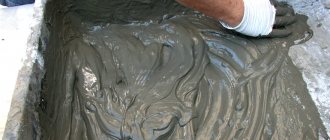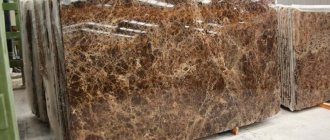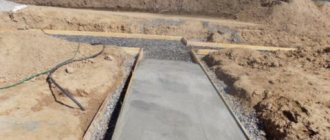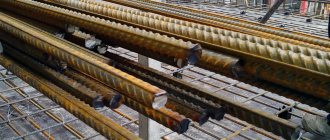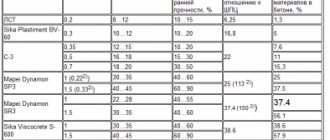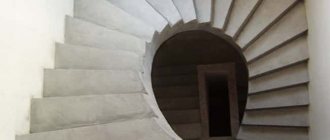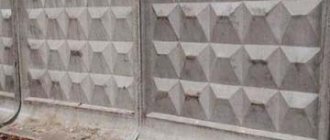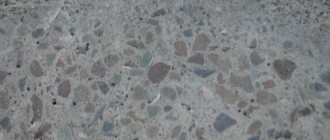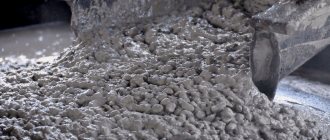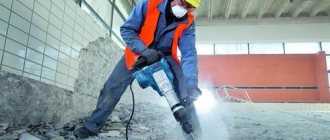What kind of concrete is used to make furniture?
The type of concrete used for furniture depends on how the product will be used - outside or indoors. As a rule, the base solution is a mixture of sand, cement grade M 400 (without additives), fine crushed stone, water (25% by weight of dry substances) and a special superplasticizer - a substance that gives the solid mixture more plasticity.
Use quality concrete.
In addition, this facilitates further work on processing the ready-made, hardened composition.
Decorative
To solve various design problems, the following can be added to the basic solution:
- pigments, preferably natural (for example, oxides of various metals);
- marble chips;
- stone filler;
- coil;
- water-repellent additives;
- additional elements for decoration.
Concrete furniture will become the highlight of the interior.
The use of various admixtures and fillers allows you to create unique pieces of concrete furniture, which become an excellent component of a modern design solution, decorate the interior, and make it original.
Features and Benefits
Concrete furniture is a functional piece of furniture that is used to decorate the interiors of residential premises and areas of country houses and gardens. The products are not afraid of shock, moisture, or temperature changes, which is achieved by treating the material with special compounds.
Concrete furniture is used in the kitchen, bathroom, living room, and every day it is becoming more and more popular, which is explained by simple arguments:
- Long service life, estimated in decades. In terms of strength and durability, furnishings are similar to similar products made from natural stone. Even when used outdoors, concrete does not crack over time, withstanding any weather conditions.
- Spectacular, unusual appearance of furniture, which will be especially appreciated by fans of expressive, extraordinary furnishings. Concrete designs are available to suit any interior style.
- The plasticity of the material allows the production of products of any shape and size. Even for the production of furniture with complex configurations, a simple formwork method is used; no expensive equipment is needed here.
- Environmental safety of furniture items due to the natural components that make up concrete.
- Compatibility of raw materials with many other materials, for example, wood, metal, glass.
- The ability to color concrete with natural pigments, which allows the production of products in any color range.
- Affordable cost of finished products.
Types of forged furniture by method of application, type of construction
If we talk about the disadvantages, outdoor concrete furniture is quite cold, sitting on it without fabric flooring is uncomfortable, and at low air temperatures it is even dangerous to health. Indoor products are not combined with all interior items, they obviously will not fit into the classical trends, so you should select a harmonious set thoughtfully, slowly. Designers advise not to concentrate many concrete products in one room - this will overload the interior.
You should carefully consider the location of the furniture, because it weighs a lot: to move a table or cabinet, you will need the joint efforts of several people at once.
How concrete furniture is made
To make concrete furniture, you need to know the features of the casting process. First, decide on the form.
The shape of the product may vary.
To form the future product, use:
- old plywood;
- laminated chipboard;
- slats;
- laminate;
- boards and other durable materials with a good water-repellent surface.
To make formwork easier, the wooden frame - form - is covered with thick plastic film. Mesh or fabric is used for reinforcement.
Leave the solution to professionals.
While the solution is soft, to decorate the upper part of the product you can use pre-dried fruits or plant leaves, beautiful pebbles, coins - whatever you like.
Additional information: objects are placed carefully on the very bottom, glued so that the dense mass does not move them during spreading and hardening.
What tools are used for work
Making concrete furniture takes a lot of time, since there is no need to rush in such a “delicate” matter - everything needs to be done carefully and carefully. You can’t do without tools and special materials.
Prepare all tools and materials.
For the manufacture of concrete furniture the following are used:
- circular saw or jigsaw (for cutting formwork);
- mixer or special attachment for a hammer drill;
- wood drills and a screwdriver (for assembling the base of the structure);
- grinding machine for processing concrete surfaces (preferably with moisture protection);
- small tools: spatulas, tape measure, square, container for mixing the base solution and others.
Please note: the number of tools you need to use in your work and their purpose may vary. This depends on the complexity of the structure being manufactured.
Important! When working with a circular saw, jigsaw and grinder, it is important to follow safety rules.
Casting technology
How is concrete furniture made—more precisely, how is it cast? There are two main methods known: direct casting and reverse casting. In the first case, the formwork is assembled (on site), the top side of the mortar will be the front side in the future.
Concrete furniture has absorbed all the quality characteristics of concrete.
In the second case, the form is assembled, the filling is done separately: the bottom becomes the top in perspective. Backfilling allows for a smoother surface, which further reduces finishing time.
Mixing the solution and pouring: stages of work
How to make a base solution? Using a mixer, of course. The composition of “furniture” concrete is already known. It was discussed above.
Concrete furniture can be created independently.
- Knead the mass.
- The mold is filled using one of the casting methods from the edges to the center.
- To avoid cavities from air bubbles, tap the sides and bottom well.
- The top is covered with a thick film and left to dry. The time of the latter depends on the thickness of the mass, its volume: sometimes 4 hours are enough, and sometimes it takes several days.
- Remove the dried product from the frame (a spatula helps): first, carefully release the side parts, then the bottom.
- The product is trimmed and cleaned with a brush dipped in water.
- The resulting sample is well polished and the surfaces are treated with special means.
Make sure the material is dry and use a spatula carefully to avoid damaging the material.
How does processing work?
Concrete furniture should not only be durable, but also visually attractive. This is achieved through further processing. Irregularities and voids are covered with an acrylic-based sealant, then the composition is allowed to dry.
The first introductions of concrete into interior design began with pedestals.
The next stage is thorough sanding. You can process the surface manually, but this will take a lot of time. It is better to use a grinder or drill with special attachments.
Using a grinder, you can make not only straight cuts, but also curly ones.
- They begin to work with a coarse-grained, rough circle. Then they change it to those with a fine fraction - 50 and 100.
- Polishing is performed with a disc with an abrasiveness of 400 units and above. It is possible to use a suede or felt nozzle. To achieve a mirror-like surface, operate at minimum speed.
- Sometimes the polishing step is omitted: they immediately use an acrylic-based varnish or primer. Then dry the treated surface.
What are furniture legs made of?
Legs for concrete furniture can be made from various materials. The main thing is to provide reliable support.
The table legs may be original.
- Metal. These can be ready-made legs, store-bought, or made yourself. Metal and concrete go together perfectly. Shiny metal and a well-polished concrete surface are an interesting option that can complement a modern room design well.
- Tree. The use of wooden stable supports and concrete is one of the common combinations. Such furniture is suitable for both outdoor and indoor spaces. Legs of unusual shapes can be made from wood. In some bold design solutions, the support can hardly be called legs. Here everything depends on the imagination and taste of the author.
- Concrete. From this material you can make legs of square, rectangular and cylindrical shapes, with bends and fancy shapes. The main thing is to have a good shape for low tide, and the technology was discussed above.
The table top can be made of wood, and the table legs can be made of concrete.
Making a concrete countertop
Concrete furniture can be bought at any store in Moscow or the regions, or you can make it yourself. To manufacture elements of various levels of complexity, you don’t need anything special, just familiar tools, several types of materials, a little knowledge and a willingness to follow technology.
Working tools and materials
To create concrete furniture you will need certain tools and materials, as well as a lot of free time to do everything carefully and accurately.
Currently reading: Stages of making a concrete slab with your own hands
What materials will be needed to create concrete furniture:
Laminated chipboard – for installation of formwork. The material has a smooth geometry and does not absorb water. Plywood is also suitable, but wrapped in plastic film. Reinforcing mesh or corrugated reinforcement rods for the contour of the frame, knitting wire for connecting elements. Cement grade M400 without additives - in a volume corresponding to the proportion and size of the element (the ratio of materials is as follows: part cement, 1 part crushed stone, 2 parts sand, maximum 25% of the total weight of dry water components). Fillers for concrete – fine crushed stone, sand. Pigments - if you plan to paint concrete (it is better to choose natural dyes - metal oxides, for example). Plasticizers - to improve the structure of the concrete mixture. Water-repellent additives can also be added to the composition. Marble chips - if you want to give the product an original texture. Silicone – for sealing the formwork structure.
Tools required to complete the work:
Circular saw – for cutting formwork parts. A jigsaw will also work. A screwdriver and a pair of 3 mm wood drills (for assembling the formwork structure). Concrete grinder – preferably suitable for wet work. Additional little things: pencil, tape measure, grinder, carpenter's square, container for mixing concrete mortar, etc.
Manufacturing of formwork
First you need to find a flat and comfortable horizontal plane to perform all the work. A sheet of chipboard is placed on it, and the contours of the parts for the formwork are marked. To make a flat, simple table (its upper part), you need to take care of a flat base and sides on the sides. The base of the formwork is cut out with a circular saw, then the side boards are made.
The blanks are cut to length according to the drawings, ensuring that all cross sections are perfect and the parts are even. The formwork is assembled with self-tapping screws (it is advisable to pre-drill holes for them), all joints are sealed.
Reinforcement and filling
The table is planned to be made with a reinforcement frame, and then filled with concrete mixture.
Main stages of work:
The reinforcing mesh is laid directly into the formwork with excess parts trimmed using a grinder or wire cutters. The dimensions are adjusted so that the edges of the mesh do not reach the walls of the formwork by 2 centimeters. Four pieces of rods are wound onto the ends of the frame (they can be cut with a grinder or a metal disc). Use a vacuum cleaner to clean the formwork from dust and dirt and wipe it with a damp cloth. Check that the silicone sealant does not get on the edges or internal parts of the formwork. Mixing concrete - first measure out and mix the plasticizer with water, pour the mixture into a container, add the dry components there, and mix everything. The solution should not be very thick so that it can be compacted easily.
Concrete is poured into the formwork up to half, distributed evenly over the surface, and compacted. Then a mesh is placed on top, the second half of concrete is poured, filling the formwork to the brim. The surface is leveled as a rule, making it even, and finishing it with a smoothing iron (the better it is done, the less sanding you will have to do later). The concrete is covered with a dark polyethylene film and allowed to dry until it gains strength. It is advisable to wait at least 7 days before dismantling the formwork.
Concrete countertop treatment
After the product has completely dried and gained strength (28 days or less), it is carefully removed from the formwork, being careful not to chip the edges. Remove concrete deposits from all open corners with an abrasive sponge.
Next to the tabletop you need to lay out several identical bars, which will act as supports, the part is turned over on them (it is advisable to lay soft rags under the supporting end).
Now you need to make the surface of the product smooth and coat it with a special protective compound. It is better to grind outdoors, treating the surface in a couple of approaches. First, the back side is cleaned, then the sides, and only after that the slab is turned over and the front surface is treated.
The first pass is made using a coarse abrasive, subsequent passes are made with a finer grit to obtain smooth concrete. The last pass is sanded using a special mastic, which is made from pigment, water, cement, and acrylic base. Such compositions can be found in a hardware store. Or choose a varnish for concrete, which is subsequently polished to a gloss.
The resulting mixture covers the entire surface of the product. Allow to dry according to instructions, then do final polishing using soft nozzles. Then the surface is made moisture resistant by covering it with acrylic primer in several layers.
Table legs
Table legs can be made from different materials - most often they choose forged metal or wood. The easiest way is to make legs from a piece of plywood and timber of various sections.
How to make wooden table legs:
From the prepared lumber, cut 4 legs and 10 lintels (lower and upper), one shelf from plywood. Prepare self-tapping screws and wood glue for joining materials. Use a jig to make holes at an angle in the parts. Carefully sand all elements until smooth, remove dust, and assemble a single structure. Coat the wood with a special impregnation to give it the desired color and protect it from moisture. Install the legs in place, place the table on top (which will be held under its own weight, but if you want to fix it rigidly, you should have embedded metal corners into the slab at the stage of pouring it into the slab).
Concrete furniture is an excellent choice for residential and non-residential premises, which can emphasize the originality of the interior and style. You can make concrete furniture yourself or purchase it in stores.
How to decorate concrete furniture
There are many ways to decorate a concrete surface. This is a creative process.
Decorating concrete furniture is not difficult.
- The simplest option is to decorate with pigments, white or colored.
- Laying ceramic tiles. A very convenient way to refine a straight horizontal surface. Its advantage is that the long and tedious stage of grinding and polishing is practically unnecessary. The tile protects the surface well from dirt and moisture, is easy to clean, and retains its original appearance for a long time. Instead of ceramics, you can use mosaic and composite tiles.
- Various fillers: beads, shell rock, seed beads, coins, colored glass or stones (marble, granite). Let us repeat that first these objects must be “planted” with glue so that the composition does not collapse at the moment of pouring the concrete mixture.
- Wood inlay. Use of valuable wood species. Concerning this option, the opinions of connoisseurs of concrete furniture are not clear. Some believe that such a combination of materials is simply ideal, while others, on the contrary, see dissonance in it: wood “breathes”, and concrete is static.
Additional information: Wood may develop cracks over time.
There are a huge number of options for concrete furniture, it’s impossible to list everything: chairs, tables, stairs, benches, table tops and more. Such products are durable and easy to care for. But you probably can’t call them easy.
Obviously, making such furniture is an art. Originality and creativity are appropriate in this matter.
Placement nuances
Designers see no restrictions in the use of concrete furniture:
- A small coffee table on wheels can be placed in the living room. Here it is appropriate to use a concrete stand for a TV or an aquarium. The material is durable, like granite, and will easily withstand any load.
- A bedside table and nightstands will look natural in the bedroom.
- Bookshelves will find their place in an office or library.
- Outdoor tables and benches are actively used in the garden, open gazebo, and summer cottage.
- But concrete is most relevant in the kitchen. Work areas are completely made from it. They look especially good in combination with wooden facades. Designers increasingly began to offer concrete bar counters and dining tables - they look original and will serve for decades. Also, some convenient little thing would be appropriate here, for example, a stand for bowls for feeding pets.
Scope of application of metal furniture, advice on selection and care
Products made from these raw materials are also actively used in the bathroom. An interesting design move is a concrete bathtub. It can be of any shape: traditional oval, round, square. Concrete sinks, shelves, racks, cabinets, and countertops can also be used. The material is ideal for the bathroom: it is not afraid of moisture, does not rot, does not rust, and lasts a long time. Shells with a rough surface look interesting. You can combine them with shiny, glossy plumbing fixtures.
Designers recommend placing sinks on wooden countertops or cabinets.
As for the garden plot, any furniture made of concrete looks appropriate here. It looks especially good surrounded by greenery and flowers. To make the products look harmonious, you should combine them with wooden elements and textiles. For example, put several small pillows on the bench - they will add coziness.
Coffee table on wheels
Bedside table
Bookshelves
Outdoor table with benches
Work area in the kitchen
Bath
Sink
Tips for placing concrete furniture:
- Products should not be placed on flower beds or lawns. It is almost impossible to move them, and caring for the plants will be significantly more complicated.
- You should not place more than 3 concrete objects nearby. Such furniture is accent, designer, it adds color to the interior or exterior. But if you make the entire furnishings from concrete, all originality will be lost and you will end up with a cold, ill-conceived design.
- It is important to choose the right size of concrete furniture, based on the area of the garden plot or room.
- Concrete products are combined with eclectic, loft, and minimalist styles. Although some designers quite successfully place such models in classic interiors.
Materials for creating furniture and methods of decorating them
Concrete furniture cannot do without accessories. The material itself is gray and cold. Bright colors are appropriate in the interior. You can put a soft fluffy rug under a concrete coffee table. Place flowers or candles on the tabletop. You can also use covers, pillows, blankets and other textiles.
It is highly undesirable to place products on flower beds or lawns, since caring for plants will be significantly more complicated
Concrete furniture is accent and adds color to any interior or exterior, so you shouldn’t make the entire furniture out of concrete
The size of the products depends on the area of the room or garden plot
Concrete interior items are combined with eclectic, loft, and minimalist styles

